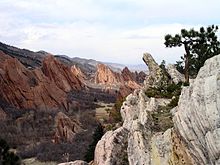Fountain Formation
| Fountain Formation Stratigraphic range: Late Pennsylvanian |
|
|---|---|

Red rocks typical of The Fountain Formation seen at Roxborough State Park near Littleton, Colorado
|
|
| Type | sedimentary |
| Underlies | Lyons Formation |
| Overlies | Gleneyrie Formation |
| Thickness | 0-4500 ft |
| Lithology | |
| Primary | sandstone, conglomerate |
| Other | limestone, shale |
| Location | |
| Region | Denver Basin |
| Extent | Colorado, Wyoming |
| Type section | |
| Named for | Fountain Creek |
| Named by | C. W. Cross, 1894 |
The Fountain Formation is a Pennsylvanian bedrock unit consisting primarily of conglomerate, sandstone, or arkose, in the states of Colorado and Wyoming in the United States, along the east side of the Front Range of the Rocky Mountains, and along the west edge of the Denver Basin.
The Fountain Formation was named by geologist W. C. Cross in 1894 for exposures along Fountain Creek in El Paso County, Colorado.
The Fountain unconformably overlies Precambrian granite and gneiss. Outcrops of the formation typically dip steeply to the east.
The formation was formed by the erosion of the Ancestral Rocky Mountains, and deposition by fluvial processes as alluvial fans.
The characteristic predominant red color and the composition of the Fountain reflect that of the granites and gneisses from which it was eroded.
Marine invertebrates have been discovered in a limestone and shale member of the Fountain Formation, cropping out on a low hogback in Perry Park. Invertebrates include bryozoans, brachiopods, crinoids, echinoids, and gastropods.
Plant fossils have been discovered in Garden Park north of Cañon City, including Lepidophloios laricinus, Sigillaria, Syringodendron sp., Lepidophyloides sp., Lepidostrobus sp., Lepidostrobophyllum sp., Calamites, Neuropterus sp., Cyclopteris sp., and Stigmaria ficoides.
...
Wikipedia
